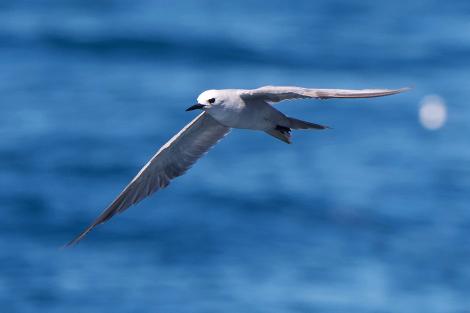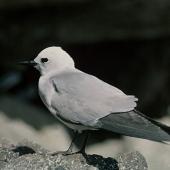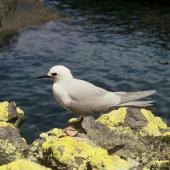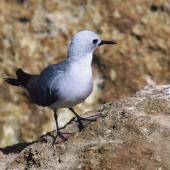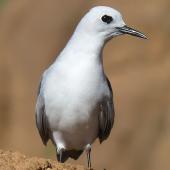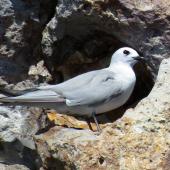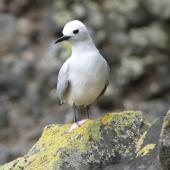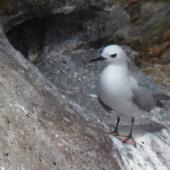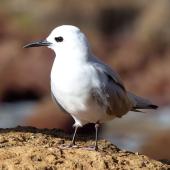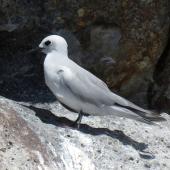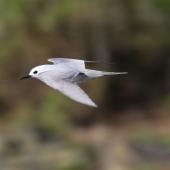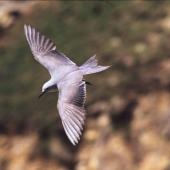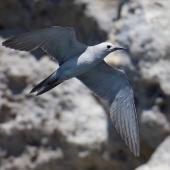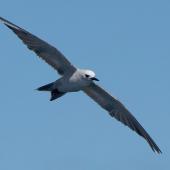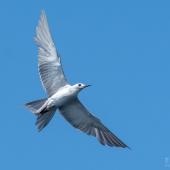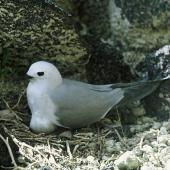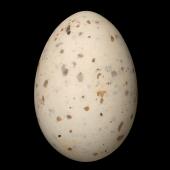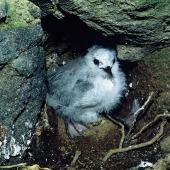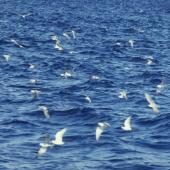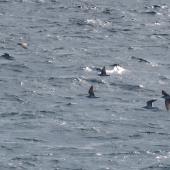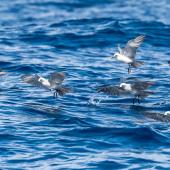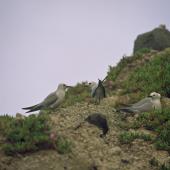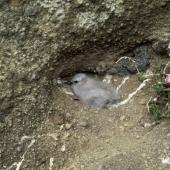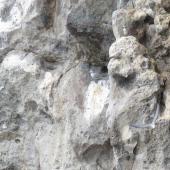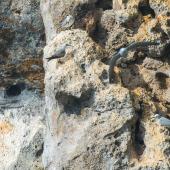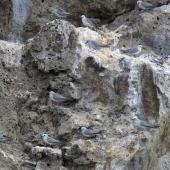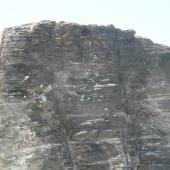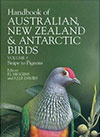Grey noddy
Anous albivittus (Bonaparte, 1856)
Order: Charadriiformes
Family: Laridae
Other names: grey ternlet, blue-grey noddy, blue-billy, gray ternlet, gray noddy, blue-gray noddy
Geographical variation: Some authorities recognise separate subspecies on Lord Howe, Norfolk, Kermadec and Austral Islands, and Tonga, (A. a. albivittus), Henderson, Easter, and Salas y Goméz Islands (P. a. skottsbergii), and San Ambrosio and San Félix Islands (P. imitatrix). Anous albivittus was previously treated as a subspecies of Anous ceruleus (=Procelsterna cerulea), which occurs in the tropical Pacific at Christmas Island, north-west Hawai’ian, Marshall, northern Tuamotu, Society, and Marqueses groups, Phoenix, Ellice, and Samoan Islands, and at Gambier group.
This small, graceful tern of the subtropical and tropical Pacific hovers and flutters using its webbed feet to patter on the sea surface while feeding, like a storm-petrel. The Latin name Procelsterna is a compounding of Procellaria, or "storm-petrel", and the Latin ‘sterna’ for a tern; ‘cerulea’ refers to its blue-grey colour. Its closest relative is the larger white tern. Both species have prominent dark eyes with a small black surrounding patch that extends from the eye towards the bill. In contrast to the pure white plumage of the white tern, the grey noddy has blue-grey wings, grading darker at the tips.
Identification
The grey noddy is a small, delicate tern with pale blue-grey upperparts, and off-white underparts. The upperwings are slightly darker than the rest of the body, with greyer or brown tinged coverts, and blackish outer flight feathers. The short tail has a shallow fork. Most birds have a thin white partial eye-ring around the back half of the eye. The black bill is slender and sharply pointed, with bright orange at the gape. The long black legs and large feet are black with pale pink webs. The sexes are alike. Juveniles are similar to adults with brownish upperparts and crown. Grey noddies fly with a deep-winged, floating, leisurely flight.
Voice: noisy screams are given in flight when flocks are disturbed, and a continuous purring cror-r-r-r while sitting on rocks.
Similar species: the white tern is larger and whiter, though grey noddy can also appear white when at a distance in bright sunlight.
Distribution and habitat
Grey noddies breed on the coasts of tropical and subtropical islands in the Pacific Ocean. In New Zealand, they breed on all of the Kermadec Islands, with 15,000 pairs estimated on Macauley and Curtis Islands. They may have bred occasionally on islands off northern New Zealand (e.g. Volkner Rocks off White Island, Sugarloaf Rock in the Alderman Islands, Maori Rocks (Cathedral Rocks) in the Mokohinau Islands, Sugarloaf Rock in the Poor Knights Islands, and West Island in the Three Kings Islands), but these sites are mainly used as post-breeding roosting sites, when warm sea temperatures in late summer provide suitable conditions for grey noddies to move south. They breed and roost mainly on cliffs or, less often, in areas of sheltered rocky ground, on beaches, or in bushy vegetation. Grey noddies feed in flocks over lagoons and inshore waters, often over upwelling currents.
Population
The total global population of grey noddies is estimated to be 27,000-120,000 birds. The New Zealand population is c. 17,000 pairs.
Threats and conservation
Introduced mammalian predators have been eradicated from the Kermadec Islands and are also absent from potential breeding sites in northern New Zealand. The IUCN Red List classifies the grey noddy as Least Concern. The Department of Conservation classifies it as naturally uncommon, range restricted and secure overseas.
Breeding
The grey noddy is a widespread annual breeder on tropical and subtropical islands of Micronesia, Melanesia and Polynesia, all in the Pacific Ocean. The timing of breeding varies with location, but is August-February on the Kermadec Islands. Courtship display includes pairs hovering in the wind and weaving across each other's flight path. During incubation, the unoccupied bird sometimes displays in front of its incubating mate by hovering in with its wings and tail raised at a c.45° angle, and making a series of U-shaped dipping flights. The single pale, freckled egg is laid August-December. Grey noddy nests are placed on cliff ledges and cliff-tops up to 600 m above sea level, and on bare rocky ground and rocky beaches out of the sun. Nests are made from grass and seaweed. Both adults share incubation of 32 days, and the chick is brooded continuously for the first 2-3 weeks. Chicks fledge after 35-37 days, and both adults continue feeding the juvenile by regurgitation for some time after fledging. Chicks peck at pink webs on adult birds' feet for food, rather than at bill as is usual with other terns.
Behaviour and ecology
Grey noddies are gregarious, breeding in loose colonies, and mainly staying within 20 km of breeding sites. Some birds disperse after breeding, including those that visit the outer Hauraki Gulf and Bay of Plenty. They usually forage in small flocks close to shore, but large flocks of over 5,000 birds sometimes form. Flocks often include a few black noddies. Grey noddies fly low over the water using quick, shallow wing-beats, dipping to catch prey at the surface. They often hover close to the water, pattering their feet on the surface like a storm-petrel, while searching for prey. They may also sit on the sea surface and paddle. When disturbed, birds resting on cliff ledges fly up and scream noisily before settling back on the ledge.
Food
Grey noddies feed on krill, tiny fish, squid and sea-striders. They have the narrowest gape of all terns and take the smallest fish (average size just 17 mm).
Weblinks
References
Checklist Committee (OSNZ). 2022. Checklist of the Birds of New Zealand (Fifth edition). Ornithological Society of New Zealand Occasional Publication No. 1. Wellington, Ornithological Society of New Zealand.
del Hoyo, J.; Elliott, A.; Sargatal, J. (eds). 1996. Handbook of the birds of the world. Vol. 3, hoatzin to auks. Lynx Edicions, Barcelona.
Heather, B.D.; Robertson, H.A. 1996. The field guide to the birds of New Zealand. Viking, Auckland.
Higgins, P.J.; Davies, S.J.J.F. (eds) 1996. Handbook of Australian, New Zealand, and Antarctic birds. Vol. 3, snipe to pigeons. Oxford University Press, Melbourne.
Robertson, C.J.R. (ed.). 1985. The complete book of New Zealand birds. Reader's Digest. Australia.
Robertson, H.A; Baird, K.; Elliott, G.P.; Hitchmough, R.A.; McArthur, N.J.; Makan, T.; Miskelly, C.M.; O’Donnell, C.F.J.; Sagar, P.M.; Scofield, R.P.; Taylor, G.A.; Michel, P. 2021. Conservation status of birds in Aotearoa New Zealand birds, 2021. New Zealand Threat Classification Series 36. Wellington, Department of Conservation. 43p.
Taylor, G. 2000. Action plan for seabird conservation in New Zealand. Part B: non-threatened seabirds. Threatened Species Occasional Publication No.17. Department of Conservation. New Zealand.
Tennyson, A.J.D. 2010. Lari. Pp. 223-243. In Checklist Committee (OSNZ) 2010. Checklist of the birds of New Zealand, Norfolk and Macquarie Islands, and the Ross Dependency, Antarctica (4th edn). Ornithological Society of New Zealand & Te Papa Press, Wellington.
Veitch, C.R.; Gaskin, C.P.; Baird, K.A.; Ismar, S.M.H. 2011. Changes in bird numbers on Raoul Island, Kermadec Islands, New Zealand, following the eradication of goats, rats, and cats. In Veitch, C.R.; Clout, M.N.; Towns, D.R. (eds): Proceedings of the Island Invasives: Eradications and Management Conference, 2010, Auckland. IUCN (World Conservation Union), Gland, Switzerland.
Veitch, C.R.; Miskelly, C.M.; Harper, G.A.; Taylor, G.A.; Tennyson, A.J.D. 2004. Birds of the Kermadec Islands, south-west Pacific. Notornis 51: 61-90.
Recommended citation
Szabo, M.J. 2013 [updated 2022]. Grey noddy. In Miskelly, C.M. (ed.) New Zealand Birds Online. www.nzbirdsonline.org.nz
Grey noddy
- Breeding season
-
- Jul
- Aug
- Sep
- Oct
- Nov
- Dec
- Jan
- Feb
- Mar
- Apr
- May
- Jun
- Egg laying dates
-
- Jul
- Aug
- Sep
- Oct
- Nov
- Dec
- Jan
- Feb
- Mar
- Apr
- May
- Jun
Grey noddy
- Social structure
- monogamous
- Breeding season
-
- Jul
- Aug
- Sep
- Oct
- Nov
- Dec
- Jan
- Feb
- Mar
- Apr
- May
- Jun
- Nest type
- cliff ledge
- Nest description
- Nest made of grass and seaweed on cliff ledges or bare rocky ground.
- Nest height (mean)
- 0.00 m
- Maximum number of successful broods
- 1
- Clutch size (mean)
- 1
- Mean egg dimensions (length)
- 42.00 mm
- Mean egg dimensions (width)
- 29.00 mm
- Egg colour
- Creamy-white or greyish-stone with variable reddish-brown freckles and spots
- Egg laying dates
-
- Jul
- Aug
- Sep
- Oct
- Nov
- Dec
- Jan
- Feb
- Mar
- Apr
- May
- Jun
- Interval between eggs in a clutch
- Not applicable
- Incubation behaviour
- shared
- Incubation length (mean)
- 32 days
- Nestling type
- precocial
- Nestling period (mean)
- 14-21 days
- Nestling period (min)
- 14 days
- Nestling period (max)
- 21days
- Age at fledging (mean)
- 35-37 days
- Age at fledging (min)
- 35days
- Age at fledging (max)
- 37days
- Age at independence (mean)
- Unknown
- Age at first breeding (typical)
- Unknown
- Maximum longevity
- Unknown
- Maximum dispersal
- Unknown




